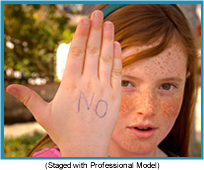
PAGE INDEX
a. Introduction to Victim Pschology
b. Recommended Guidelines for Talk Shows and Crime Victim Guests
Talk Show Guidelines for Crime Victim Guests
 In response to the concern that crime victims are being revictimized during their appearances on television talk shows, the National Center for Victims of Crime developed specific guidelines alerting television talk show staff to the specific needs of crime victims. . .
In response to the concern that crime victims are being revictimized during their appearances on television talk shows, the National Center for Victims of Crime developed specific guidelines alerting television talk show staff to the specific needs of crime victims. . .
a. Introduction to Victim Psychology
When a person has been victimized by crime, the traumatic event transforms his or her life. Appropriate support and treatment can help a victim reconstruct a new life.

[Victims often lose a sense of control over their life.] One of the most important services to provide to a victim is information and the ability to make decisions based on that information. This sense of control does not just apply to the investigation and prosecution of their case—it also applies to retelling of their story to the media. It’s critical that the victim’s requests be respected and followed to avoid inflicting a second victimization.
While working with a crime victim who has agreed to appear on television, . . .[it’s important for] members of the media to be sensitive to the trauma the person has experienced. Agreeing to tell their story should not be construed as a sign that the trauma of their victimization is no longer a factor to be considered. . .[To] the contrary, a person who has been traumatized by crime often does not know when, or if, an event will “trigger” a crisis reaction. Appearing on air, whether television or radio, is a new and potentially intimidating experience for most people. This anxiety. . .and the retelling of their story, combined with the trauma of victimization, creates an environment in which a victim needs additional support and control over the situation. The guidelines outlined in this document have been designed to minimize the possibility of a second victimization inflicted by the mishandling of a victim or his/her story by the media.
b. Recommended Guidelines for Talk Shows and Crime Victim Guests
- Television talk shows should use only victims who have had the benefit of counseling and guidance from a trained victim counselor, advocate, or other professional (i.e., rape counselor, domestic violence advocates, legal counsel, etc.). A surprising number of victims end up on shows in the immediate aftermath of their victimization. This is primarily due to the fact that production staff learn about victims through news media accounts and then contact the victims directly. Because of the short time frame, many victims will not have had the opportunity to speak with a victim advocate or counselor to begin processing what has happened to them and what they can expect in the aftermath of their victimization. In the aftermath, most victims experience a cataclysm of emotions and are generally not in the best frame of mind to consider the emotional, mental, or legal consequences associated with telling their story on television.
- Crime victims should not appear in the immediate wake of their victimization— particularly if they have not had the advantage of counseling by professional victim advocates and service providers. It is crucial that victims understand the potential risks involved in telling their story on a television talk show. When victim guests have not had the benefit of guidance and counseling from victim professionals, they may feel intimidated by production staff and/or the studio environment. This inexperience may lead them to consent to decisions that are not in their own best interests simply because they do not know they can object or do not feel comfortable doing so. The first and perhaps most important consideration is the emotional impact of appearing on television so soon after the crime has occurred. A second consideration is the potentially devastating impact that the premature telling of the victim’s story may have on the criminal investigation and subsequent prosecution of the case, as well as any potential civil litigation pursued by the victim.
- Child victims generally should not be guests. Children who are already suffering from the trauma of their victimization are easily re-traumatized and/or re-victimized by exposure to the media. Also, children inherently lack the means to verbalize their emotions to the same extent as adults and thus, what they say can be easily misinterpreted by both the media and the public. Because of their inexperience with life, and thus being less able to envision and understand the ultimate consequences of their decisions, children are extremely vulnerable to exploitation by the media. Appearing on a television talk show, and thereby revealing their identity to their community and the world, may forever stigmatize them as victims to their peers and the public and have continuing negative effects on their developmental years. While child victims may not suffer negative emotional consequences in all cases, the risks are so high that children generally should not be guests. There may be special circumstances that reduce the risks sufficiently to consider an appearance—for example, the age of the child. There is a significant difference between a 7-year-old and a 17-year-old.

- A professionally trained victim advocate and crisis counselor should be on hand at all times. Utilizing the services of a trained crisis counselor or victim advocate. . .results in guests who are more comfortable and relaxed, more cooperative, and better prepared for the interview and appearance on air. There are many instances in which victim guests who were not properly prepared or who were not really ready to go public with their story were unable to talk about it once tape was rolling or the broadcast began. Having a trained crisis counselor or victim advocate present in the green room with the crime victim guests is important not only for the several hours before the taping or live broadcast begins but also for a period of debriefing after their appearance is over. A trained victim counselor can monitor the crime victim’s appearance for signs of excessive stress, trauma or PTSD and then lend assistance as necessary.
- Crime victim guests should be treated with dignity and respect at all times. Talk show hosts and production staff should be particularly sensitive and understanding of a victim guest’s emotions and feelings, which may be heightened by the stress of appearing on a television talk show. Being sensitive to crime victims’ emotions and letting them know that their emotional reactions are okay is very different from requesting that they cry and show their emotions on the air. Crime victims’ emotional reactions are highly personal experiences that they may not wish to share publicly.

- Crime victims should always be fully informed about the format of the show; how their story will be told; who else will appear (in person or from a remote location); and what subjects will be discussed with each guest. Whenever possible, victims should be provided with copies of the producer’s notes on each guest. The purpose here is not only to avoid surprises in terms of guests, material, and subject matter but to also give victims the information they need to negotiate their involvement and to prepare for the show. Reducing the unknown will dramatically reduce the victims’ fear and trepidation about the show. It will also help them to tell their story more effectively and to defend themselves against insensitive questions or comments from the host or other guests.
- If any offender (including his or her own) is to be physically present in the studio or elsewhere in the facility, the victim should be given notice of the specific facts and asked what arrangements can be made in the studio to make the victim feel comfortable and safe (e.g., a physical barrier like a table or floral arrangement between the offender and the victim, interviewing the offender via satellite or from a remote location on the premises, etc.). Every precaution should be taken to prevent the offender and the victim from “crossing paths” before, during, and after the show. One of the most often stated needs of a crime victim is access to information relating to his/her victimization, case, or offender. By knowing if an offender, any offender, is going to appear on the show with the victim, the victim will be better able to prepare for that portion of the show. It will also be helpful to the victim to know as much about what the offender will be discussing during his/her interview.
- Offer victims the opportunity to get comfortable with the set by allowing them to arrive early or even the day before the actual taping. Crime victims’ stress can be reduced when they are prepared in advance by familiarizing themselves with the environment in which the interview or appearance will take place. This involves touring the studio with explanations provided of where the interviewer/host will be, where the audience will be situated, where camerapersons will be located, and which monitor they should look at.
- Victims should always have the right to view pictures, video/audio tape, graphic and/or any other depictions that will air as part of the show. Again, victims should not be surprised with graphic representations they have not seen and approved in advance. Victim guests should always have the right to ask about the airing of photographs, and to veto the airing of any visual depictions they find offensive or feel are inappropriate.

- Victims should be informed in advance of the option to protect their anonymity by whatever means are necessary (for example, silhouette screens, disguises, electronic voice alteration, pixel and fog screening). Anonymity is important to victims, not only to protect them from embarrassment and stigmatization from the general public, but in some cases from harassment and threats to their safety.
- When the victims desire, no information should be presented that would disclose the location of their home, place of work, or whereabouts. For stalking victims and those who have gone into hiding to escape their abusers, the need for absolute confidentiality about their place of residence and employment is critical for their safety. Care should be given so that no clues as to the victims’ current location are given.
- Victims should also be informed of when the original show will air and, when possible, when the show will be rebroadcast. This will give victims the opportunity to make any arrangements they feel are necessary in advance of the broadcast or re-broadcasts. Especially in the instance of a possible rebroadcast, victim guests should be informed whenever possible. . .Their situation may have changed (for example, the offender may now be out of prison, the criminal acts may have started again or accelerated) and any rebroadcast could potentially put them in physical danger.
- Victims in the viewing audience may experience a crisis reaction while watching a show about crime victimization experience.
 A television program that features crime victims detailing their stories and experiences, especially if graphic depictions of the crime scene are involved, will often trigger crisis reactions for viewers both in the studio and viewing audience, who have also been crime victims at some point in their lives. Therefore, it is strongly advised that talk show producers provide a disclaimer at the beginning of their show cautioning viewers of the content. Also producers should provide a public service announcement at the end of the show advising viewers that there is help available for them and provide the name of an appropriate, qualified victim information and referral phone line that can provide more information and referrals to local victim assistance programs in the viewers’ area.
A television program that features crime victims detailing their stories and experiences, especially if graphic depictions of the crime scene are involved, will often trigger crisis reactions for viewers both in the studio and viewing audience, who have also been crime victims at some point in their lives. Therefore, it is strongly advised that talk show producers provide a disclaimer at the beginning of their show cautioning viewers of the content. Also producers should provide a public service announcement at the end of the show advising viewers that there is help available for them and provide the name of an appropriate, qualified victim information and referral phone line that can provide more information and referrals to local victim assistance programs in the viewers’ area.
This section is an abridged version of the original “Talk Show Guidelines for Crime Victim Guests” intended for talk show producers and staff. It is reproduced with permission of the National Center for Victims of Crime, Washington, D.C. 2007. To view the document in its entirety, please visit www.ncvc.org/ncvc/main.aspx?dbName=DocumentViewer&DocumentID=32566.




